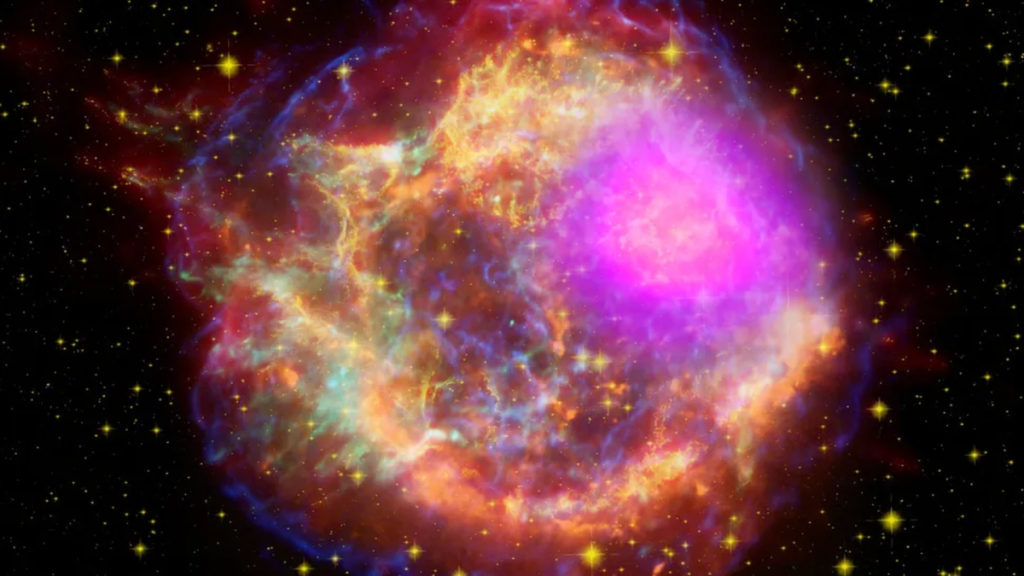
Over 10,000 exploding stars catalogued by groundbreaking Zwicky Transient Facility (Image Credit: Space.com)
The Zwicky Transient Facility has reached an incredible milestone: It has classified over 10,000 cosmic explosions that mark the deaths of massive stars and the feeding frenzies of vampire stellar remnants. These events, called supernovas, are undoubtedly some of the most fearsome and powerful events in the universe.
Since 2012, humanity has discovered almost 16,000 supernovas. The Zwicky Transient Facility (ZTF), which began operations in 2017 using the 48-inch telescope at Palomar Observatory, is responsible for almost two-thirds of these detections. That makes it the largest and arguably most successful supernova surveyor to date.
“There are trillions of stars in the universe, and about every second, one of them explodes,” California Institute of Technology astronomer Christoffer Fremling said in a statement. “Reaching 10,000 classifications is amazing, but what we truly should celebrate is the incredible progress we have made in our ability to browse the universe for transients, or objects that change in the sky, and the science our rich data will enable.”
Fremling is the leader of the Bright Transient Survey, an endeavor that uses the ZTF to discover and classify new supernovas.
It should probably come as no surprise that the ZTF has been so revolutionary in supernova science because it has pedigree even in its name. The project is named for Caltech astronomer Fritz Zwicky.
In the 1930s, Zwicky began hunting cosmic explosions with a small telescope from the frigid heights of the Palomar Mountain near San Diego. By the 1940s, Zwicky moved his hunt for supernovas to the 48-inch Samuel Oschin telescope at Palomar Observatory, along with his collaborator, Walter Baade.
Together, Zwicky and Baade discovered a multitude of these explosions, coining the term “supernova” to describe them. Finding over 120 supernovas across his career, Zwicky, who passed away in 1974, held the record for hunting these stellar explosions until 2009. Now, the supernova-hunting facility that shares Zwicky’s name continues his record-setting work.
Why supernova classification matters
The ZTF doesn’t just hunt supernovas. This project is capable of detecting a range of transient astronomical events, which are events that occur and then fade from the sky.
Transient events tracked by the ZTF include rapidly moving asteroids in the solar system, black holes ripping apart stars and devouring them in so-called tidal disruption events (TDEs), and colliding stars that eventually merge.
The ZTF detects hundreds of thousands of these transient events each night. Once verified, these detections are sent to an astronomy database called the “Transient Name Server.” From there, they are available to the astronomical community as a whole. This allows astronomers to follow up on the detection of supernovas using a range of telescopes around the globe.
ZTF principal investigator and Caltech astronomer Mansi Kasliwal says that the “name of the game” for ZTF studying supernovas is to obtain spectra.
“Discovery is only the first step,” she said. “Spectra are the most valuable currency in this field. You don’t know the physics and chemistry of the object without that.”
Obtaining the spectrum of light from these supernovas allows scientists to determine a range of characteristics. That includes their distances from Earth, the chemical compositions of the stars from which they erupted, and, crucially, what type of supernova the ZTF has witnessed.
The supernovas that relate to the deaths of massive stars are referred to as core-collapse supernovas. They occur when massive stars run out of fuel for nuclear fusion, and the outward flow of energy that supports them against the inward push of gravity ceases.
The core of the massive star collapses to create a neutron star or a black hole. This collapse sends shockwaves rippling into the outer layers of the star, causing a core-collapse supernova.
Another type of supernova occurs when the remnant of an already dead star, a white dwarf, vampirically strips material away from a companion star. This material builds up on the surface of the white dwarf, triggering a thermonuclear explosion, which is seen as a Type Ia supernova.
This process usually obliterates the white dwarf, but there are rare events called Type-Iax supernovas in which the stellar remnant lives on as a ravaged “zombie star.”
It is vitally important to identify Type Ia supernovas because they are a crucial astronomical tool. Because the light output of Type Ia explosions are so uniform, they are known as “standard candles,” and they can be used as milestones on a giant cosmic measuring stick.
The ZTF doesn’t just hunt supernovas for other facilities to identify, however. Using two spectrographs at Palomar Observatory, the ZTF project can also classify its own supernovas and supernovas detected by other facilities.
“Back when we started this project, we didn’t know how many astronomers would follow up on our detections,” Fremling said. “To see that so many have is a testament to why we built ZTF: to survey the whole sky for changing objects and share those data as rapidly as possible with astronomers around the world.”
One of the project’s biggest achievements was the discovery of Supernova Zwicky (SN Zwicky), a cosmic explosion warped by an effect called “gravitational lensing,” which allowed it to appear four times in the same image.
“I was observing that night and was absolutely stunned when I saw the lensed image of SN Zwicky,” Fremling explained in a Caltech news story last year. “We catch and classify thousands of transients with the Bright Transient Survey, and that gives us a unique ability to find very rare phenomena such as SN Zwicky.”
Moving forward from this milestone, data from the ZTF will continue to help astronomers answer questions about stellar life and death — and may even assist in solving the mystery of dark energy, the unknown force driving the acceleration of the expansion of the universe.
Zwicky’s legacy of supernova science is in good hands.









